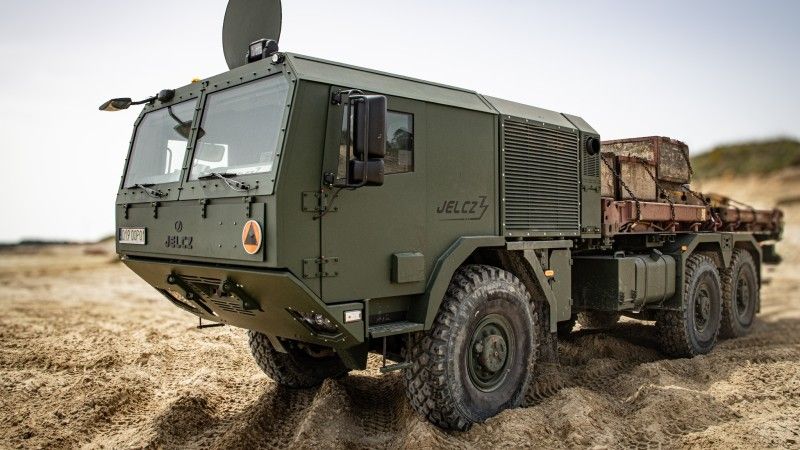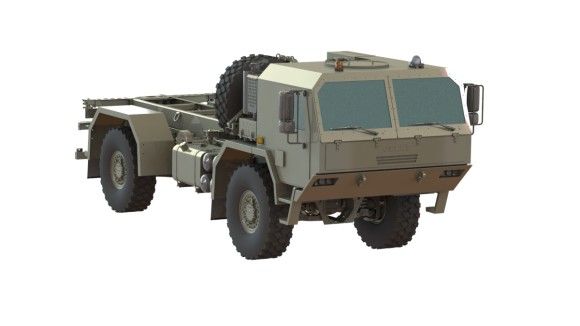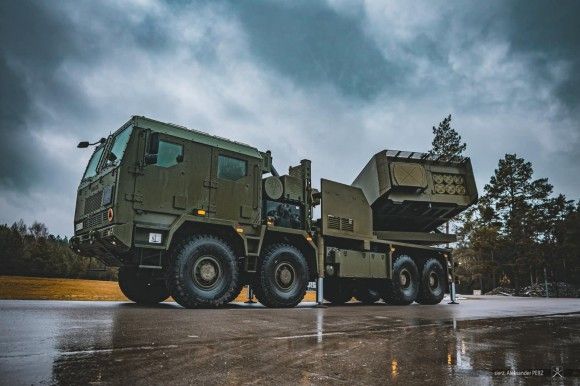Industry
Jelcz Looks to the Future. New Trucks Coming Soon [INTERVIEW]

Photo. Justyna Orzechowska / Jelcz Sp. z o.o.
New Jelcz trucks will soon enter state trials. We sit down with Paweł Marciczkiewicz, Chief Designer at Jelcz Sp. z o.o., to discuss what gives the third-generation off-road trucks an edge over their predecessors.
At last year’s International Defense Industry Exhibition in Kielce, Jelcz introduced its entirely new vehicles, collectively known as the third generation.
Not far from the main entrance of the Kielce Trade Fair, two prototypes were showcased: a 6x6 model called 663.45 and the 8x8 883.57. As of early September, both vehicles have returned to Świętokrzyskie Voivodeship’s capital. Today, they are undergoing a factory test programme. They are set to soon enter qualification trials conducted by state institutions. We spoke with Mr. Marciczkiewicz, head of this project, about the programme’s progress and what the future holds for Jelcz trucks.
Antoni Walkowski, Defence24: The third-generation Jelcz trucks are entirely new. The chassis, cabin, suspension, brakes, and drivetrain have all been thoroughly revamped. What led to such a comprehensive reconfiguration?
Paweł Marciczkiewicz, Chief Designer, Jelcz Sp. z o.o.: We have been implementing evolutionary upgrades to our older models, incorporating new solutions proven in projects like Wisła, Sajna, and Jak. However, Jelcz hadn’t previously included vehicles with independent suspension in its portfolio. The introduction of this feature coincided with military requirements for the WWR project (Homar-A and Homar-K multiple launch rocket artillery systems – editor’s note).
Have any components from the older models made it into the 663 and 883 models showcased last year at MSPO?
There are few shared components, but that does not mean there are none. In the third-generation vehicles with 4x4 and 8x8 configurations, we have used the same engines currently found in our existing products. However, overall, these trucks have been designed from the ground up.

Photo. Justyna Orzechowska / Jelcz Sp. z o.o.
Is a prototype of the 4x4 model already in development?
It is, and by Q4, it will be standing on its wheels. According to the plan, factory testing will begin at that time, followed by state trials.
Novel approach
The powertrain in these new vehicles is located behind the cabin. Why was this decision made?
The main goal was to maximize cabin space. Mounting the powertrain behind the cab eliminated the engine tunnel, which took up a lot of room. Now, we have a relatively short cabin capable of carrying up to four soldiers, with seats positioned almost at the same level, allowing the crew to move freely within the cabin. This is the biggest advantage of this configuration.
Additionally, when designing those vehicles, we also aimed to improve the serviceability of the engine, which is a crucial factor for the military.
You mentioned independent suspension. What advantages does this offer over traditional rigid axles?
The primary advantage is the increased comfort during off-road driving. Independent suspension handles uneven terrain better, ensuring near-constant contact with the ground. This improves the vehicle’s steering and handling and enhances safety.
These new models also perform better off-road. Larger wheels with 16.00R20 tires (Michelin X-Force off-road tires were used – editor’s note) improve approach, breakover, and departure angles. While independent suspension doesn’t significantly affect obstacle tackling capabilities, it does improve mobility and work comfort, as I mentioned.

Photo. Jelcz Sp. z o.o.
I assume this also reduces shock loads transmitted from the wheels to the chassis and cabin?
Indeed. Independent suspension adapts better to the terrain, allowing us to travel faster and more comfortably while maintaining similar load-bearing capacity.
You recently published photos of the 663 and 883 during factory testing. Can we assume the next step is transferring these vehicles to an independent testing facility to verify compliance with military tactical and technical requirements?
That’s the goal. We’re currently conducting factory tests, which will count towards qualification trials. Ultimately, the vehicles will be handed over to an independent institution for endurance testing and verification of their tactical and technical parameters.
How did the factory tests go? Have any changes been made to the design?
Factory tests are meant to verify technical parameters before sending the vehicles for qualification. So far, the trucks are performing excellently, and no major modifications have been necessary. Any adjustments will be made after the qualification tests.
Tailored to requirements
What are these models intended for? Are they solely specialized platforms? Or could they become the foundation of Jelcz’s future lineup?
The third-generation trucks could potentially replace most of our existing models. The first prototypes are designed to carry ISO containers, partly because such vehicles can easily be loaded with test weights to conduct endurance tests that assess the chassis under load. Once adapted, the trucks will serve as platforms for specialized applications. Given the Polish Armed Forces« demand for new systems, we believe these vehicles will be widely used in future projects. We’re currently engaged in technical discussions with the contracting authority about using “independent” chassis in ongoing contract negotiations.

Photo. Polska Grupa Zbrojeniowa
So the customer will be able to choose between a chassis with classic or independent suspension?
Jelcz has developed both chassis types. To meet the client’s needs, we can also offer a mixed suspension system, combining rigid axle and independent setups. For example, independent suspension could be used at the front for crew comfort, with a classic setup at the rear for increased stability in vehicles with top-heavy specialist equipment.
That would make the vehicle a suitable platform for long-range radar stations, for instance, with that independent-front, conventional-rear suspension setup?
Exactly. That’s why we want to introduce a mixed suspension option. Some setups require increased platform stability.
The visualizations you’ve shown to the public include configurations from 4x4 to 10x10. The 6x6 and 8x8 trucks are currently undergoing factory testing, while the 4x4 is in development. What about the 10x10?
The 10x10 chassis is in development. We’re working on the technical documentation, though I can’t yet reveal which project it will be used for. But it’s already on the drawing board.
So, we’re talking about four main variants of the third generation, all of which are either in development or have already been built and are undergoing testing.
Yes. Our primary objective is to introduce vehicles with independent suspension into the Polish Armed Forces. These trucks, particularly the 6x6 and 8x8 configurations, will serve as platforms for rocket launchers in the Homar-A and Homar-K programs.

Photo. Sergeant Aleksander Perz / 18th Mechanized Division
Is there a possibility that the 3rd-generation Jelcz trucks could eventually replace all the trucks currently in service with the Polish Army?
Certainly, that possibility exists, but we can’t completely abandon vehicles with conventional suspension systems, as they still perform well in their current roles.
Long-term development
Right. The 442.32 S02, a classic off-road truck with four wheel drive and a flatbed body, the successor of the Star 266, remains your most popular product.
Yes, it’s a high-mobility vehicle that performs really well in the jobs the military has given it.
How do you see the long-term development of the 3rd generation? Besides various suspension systems, drivetrains, and powertrains, can we expect changes in the configuration of specialist bodies or new cabins?
As I mentioned, the 3rd-generation Jelcz is a completely new vehicle. It’s currently undergoing tests, so our focus now is on refining the design. Naturally, we’re already thinking about new projects using these solutions. We have plenty of ideas and plans.
So, you’re creating a whole family or range of vehicles that will have a wide range of applications in the future. What else has changed compared to the older models?
We’ve implemented automatic transmissions in these vehicles. In the T80 (model 883.57 T80 TS 8x8, the future platform for the Homar-K system), it’s the ZF EcoLife transmission with seven speeds, integrated with the engine. In the T60 (663.45 T60 TS 6x6, the base chassis for the Homar-A launcher), we’ve installed a similar transmission, but with six speeds. In previous models, we used automated mechanical transmissions with electronic control units.

Photo. Polish MoD / Flickr
Like the one in the 882.57 T28 TS ASV-H 8x8 artillery ammunition carrier, which I had the pleasure of riding in last year.
Exactly.
